University Report: Globalisation, Trade, and US Tariff Policies
VerifiedAdded on 2022/08/08
|7
|1959
|52
Report
AI Summary
This report provides a comprehensive analysis of globalisation and its multifaceted impacts on domestic businesses, encompassing both positive and negative consequences. It delves into the core concepts of international trade by comparing and contrasting the absolute and comparative advantage theories, assessing their practical applicability, and illustrating their principles with a numerical example involving two countries and two products. Furthermore, the report examines the rationale behind the imposition of tariffs on Chinese imports by the former US President Donald Trump, exploring the underlying motivations and potential implications for domestic consumers. The analysis is supported by academic sources, providing a well-rounded understanding of the complex interplay between globalisation, trade policies, and their effects on the global economic landscape.

qwertyuiopasdfghjklzxcvbnmqw
ertyuiopasdfghjklzxcvbnmqwert
yuiopasdfghjklzxcvbnmqwertyui
opasdfghjklzxcvbnmqwertyuiop
asdfghjklzxcvbnmqwertyuiopasd
fghjklzxcvbnmqwertyuiopasdfgh
jklzxcvbnmqwertyuiopasdfghjkl
zxcvbnmqwertyuiopasdfghjklzxc
vbnmqwertyuiopasdfghjklzxcvb
nmqwertyuiopasdfghjklzxcvbnm
qwertyuiopasdfghjklzxcvbnmqw
ertyuiopasdfghjklzxcvbnmqwert
yuiopasdfghjklzxcvbnmqwertyui
opasdfghjklzxcvbnmqwertyuiop
asdfghjklzxcvbnmqwertyuiopasd
fghjklzxcvbnmqwertyuiopasdfgh
jklzxcvbnmrtyuiopasdfghjklzxcv
Management
ertyuiopasdfghjklzxcvbnmqwert
yuiopasdfghjklzxcvbnmqwertyui
opasdfghjklzxcvbnmqwertyuiop
asdfghjklzxcvbnmqwertyuiopasd
fghjklzxcvbnmqwertyuiopasdfgh
jklzxcvbnmqwertyuiopasdfghjkl
zxcvbnmqwertyuiopasdfghjklzxc
vbnmqwertyuiopasdfghjklzxcvb
nmqwertyuiopasdfghjklzxcvbnm
qwertyuiopasdfghjklzxcvbnmqw
ertyuiopasdfghjklzxcvbnmqwert
yuiopasdfghjklzxcvbnmqwertyui
opasdfghjklzxcvbnmqwertyuiop
asdfghjklzxcvbnmqwertyuiopasd
fghjklzxcvbnmqwertyuiopasdfgh
jklzxcvbnmrtyuiopasdfghjklzxcv
Management
Paraphrase This Document
Need a fresh take? Get an instant paraphrase of this document with our AI Paraphraser
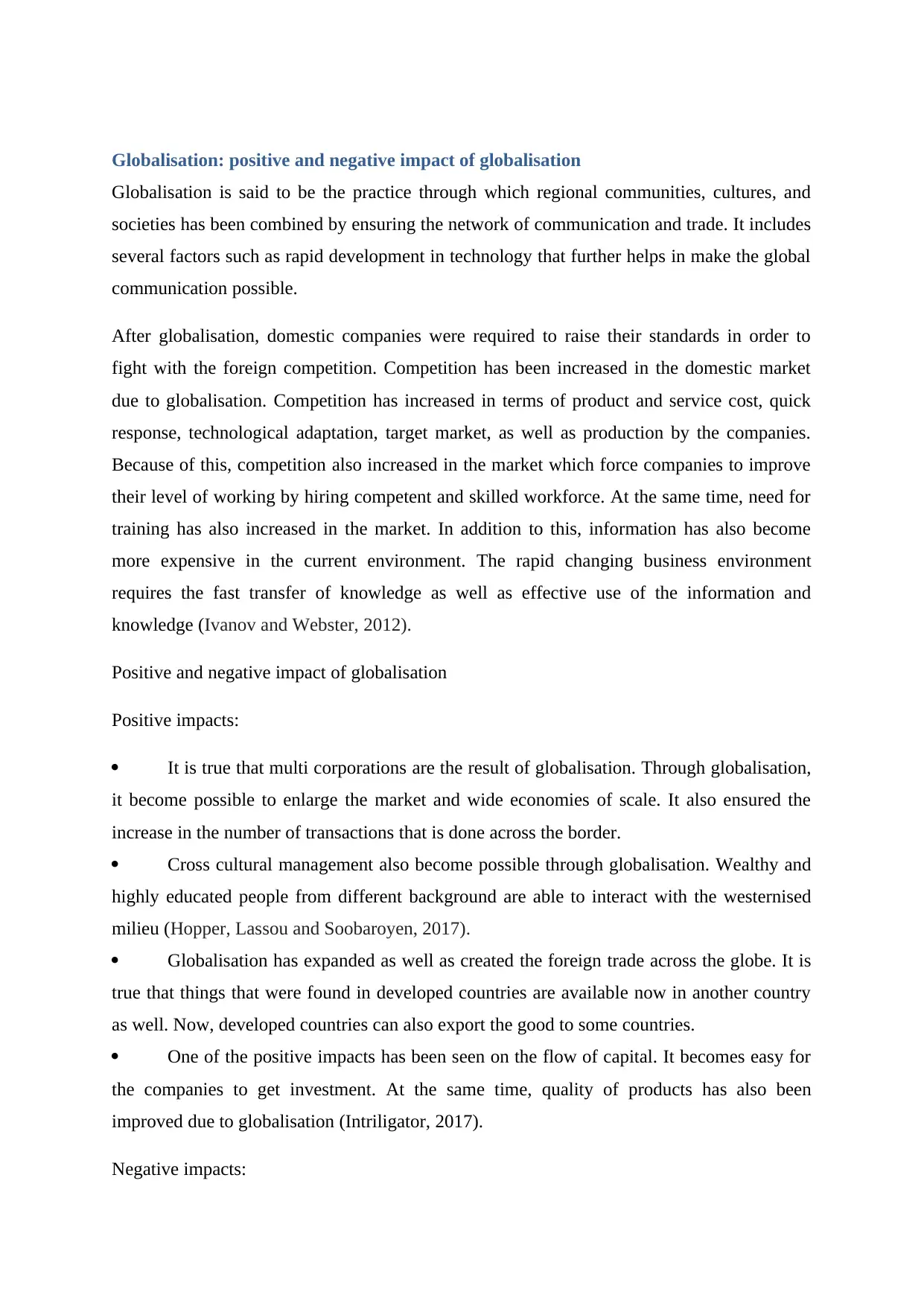
Globalisation: positive and negative impact of globalisation
Globalisation is said to be the practice through which regional communities, cultures, and
societies has been combined by ensuring the network of communication and trade. It includes
several factors such as rapid development in technology that further helps in make the global
communication possible.
After globalisation, domestic companies were required to raise their standards in order to
fight with the foreign competition. Competition has been increased in the domestic market
due to globalisation. Competition has increased in terms of product and service cost, quick
response, technological adaptation, target market, as well as production by the companies.
Because of this, competition also increased in the market which force companies to improve
their level of working by hiring competent and skilled workforce. At the same time, need for
training has also increased in the market. In addition to this, information has also become
more expensive in the current environment. The rapid changing business environment
requires the fast transfer of knowledge as well as effective use of the information and
knowledge (Ivanov and Webster, 2012).
Positive and negative impact of globalisation
Positive impacts:
It is true that multi corporations are the result of globalisation. Through globalisation,
it become possible to enlarge the market and wide economies of scale. It also ensured the
increase in the number of transactions that is done across the border.
Cross cultural management also become possible through globalisation. Wealthy and
highly educated people from different background are able to interact with the westernised
milieu (Hopper, Lassou and Soobaroyen, 2017).
Globalisation has expanded as well as created the foreign trade across the globe. It is
true that things that were found in developed countries are available now in another country
as well. Now, developed countries can also export the good to some countries.
One of the positive impacts has been seen on the flow of capital. It becomes easy for
the companies to get investment. At the same time, quality of products has also been
improved due to globalisation (Intriligator, 2017).
Negative impacts:
Globalisation is said to be the practice through which regional communities, cultures, and
societies has been combined by ensuring the network of communication and trade. It includes
several factors such as rapid development in technology that further helps in make the global
communication possible.
After globalisation, domestic companies were required to raise their standards in order to
fight with the foreign competition. Competition has been increased in the domestic market
due to globalisation. Competition has increased in terms of product and service cost, quick
response, technological adaptation, target market, as well as production by the companies.
Because of this, competition also increased in the market which force companies to improve
their level of working by hiring competent and skilled workforce. At the same time, need for
training has also increased in the market. In addition to this, information has also become
more expensive in the current environment. The rapid changing business environment
requires the fast transfer of knowledge as well as effective use of the information and
knowledge (Ivanov and Webster, 2012).
Positive and negative impact of globalisation
Positive impacts:
It is true that multi corporations are the result of globalisation. Through globalisation,
it become possible to enlarge the market and wide economies of scale. It also ensured the
increase in the number of transactions that is done across the border.
Cross cultural management also become possible through globalisation. Wealthy and
highly educated people from different background are able to interact with the westernised
milieu (Hopper, Lassou and Soobaroyen, 2017).
Globalisation has expanded as well as created the foreign trade across the globe. It is
true that things that were found in developed countries are available now in another country
as well. Now, developed countries can also export the good to some countries.
One of the positive impacts has been seen on the flow of capital. It becomes easy for
the companies to get investment. At the same time, quality of products has also been
improved due to globalisation (Intriligator, 2017).
Negative impacts:
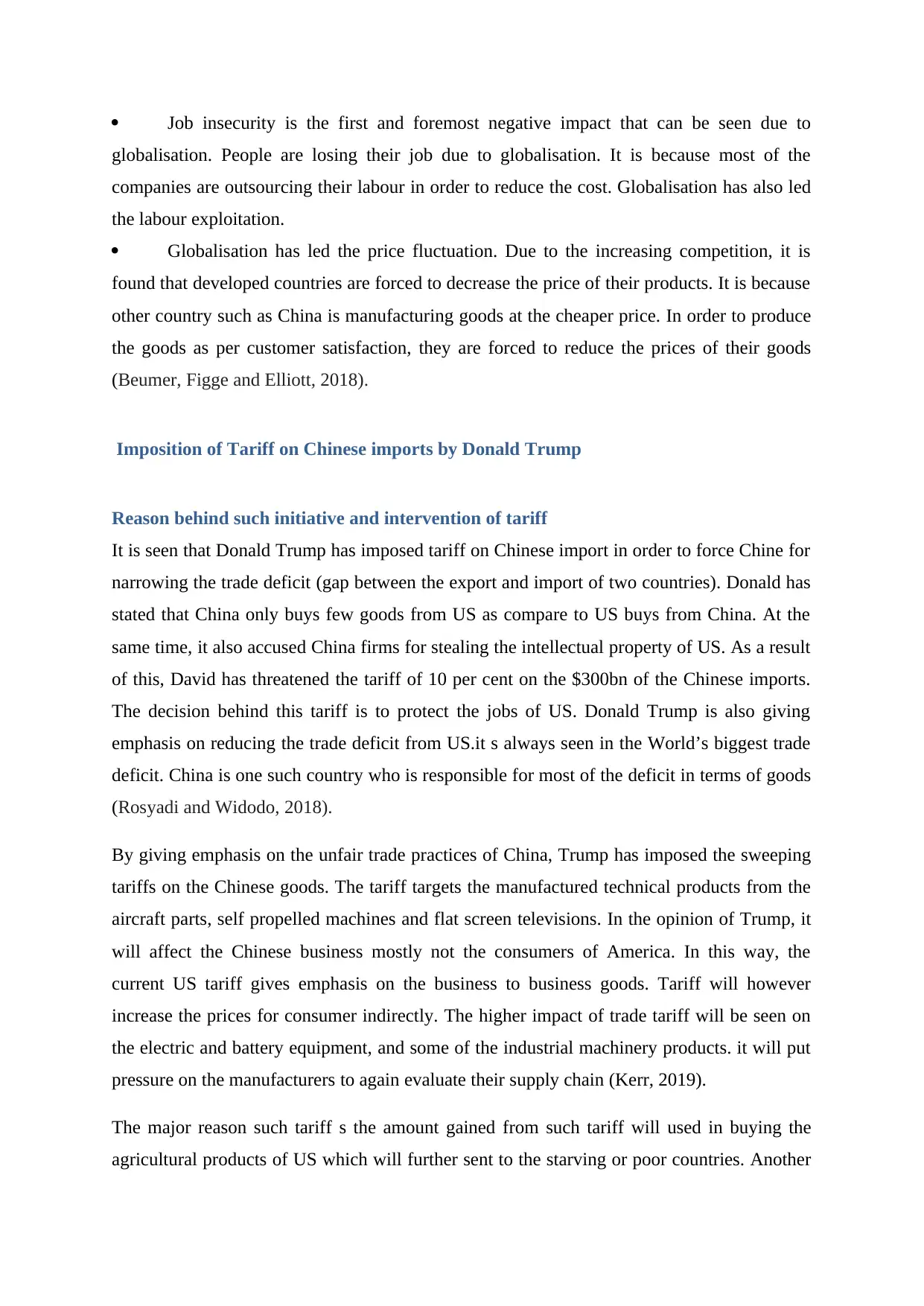
Job insecurity is the first and foremost negative impact that can be seen due to
globalisation. People are losing their job due to globalisation. It is because most of the
companies are outsourcing their labour in order to reduce the cost. Globalisation has also led
the labour exploitation.
Globalisation has led the price fluctuation. Due to the increasing competition, it is
found that developed countries are forced to decrease the price of their products. It is because
other country such as China is manufacturing goods at the cheaper price. In order to produce
the goods as per customer satisfaction, they are forced to reduce the prices of their goods
(Beumer, Figge and Elliott, 2018).
Imposition of Tariff on Chinese imports by Donald Trump
Reason behind such initiative and intervention of tariff
It is seen that Donald Trump has imposed tariff on Chinese import in order to force Chine for
narrowing the trade deficit (gap between the export and import of two countries). Donald has
stated that China only buys few goods from US as compare to US buys from China. At the
same time, it also accused China firms for stealing the intellectual property of US. As a result
of this, David has threatened the tariff of 10 per cent on the $300bn of the Chinese imports.
The decision behind this tariff is to protect the jobs of US. Donald Trump is also giving
emphasis on reducing the trade deficit from US.it s always seen in the World’s biggest trade
deficit. China is one such country who is responsible for most of the deficit in terms of goods
(Rosyadi and Widodo, 2018).
By giving emphasis on the unfair trade practices of China, Trump has imposed the sweeping
tariffs on the Chinese goods. The tariff targets the manufactured technical products from the
aircraft parts, self propelled machines and flat screen televisions. In the opinion of Trump, it
will affect the Chinese business mostly not the consumers of America. In this way, the
current US tariff gives emphasis on the business to business goods. Tariff will however
increase the prices for consumer indirectly. The higher impact of trade tariff will be seen on
the electric and battery equipment, and some of the industrial machinery products. it will put
pressure on the manufacturers to again evaluate their supply chain (Kerr, 2019).
The major reason such tariff s the amount gained from such tariff will used in buying the
agricultural products of US which will further sent to the starving or poor countries. Another
globalisation. People are losing their job due to globalisation. It is because most of the
companies are outsourcing their labour in order to reduce the cost. Globalisation has also led
the labour exploitation.
Globalisation has led the price fluctuation. Due to the increasing competition, it is
found that developed countries are forced to decrease the price of their products. It is because
other country such as China is manufacturing goods at the cheaper price. In order to produce
the goods as per customer satisfaction, they are forced to reduce the prices of their goods
(Beumer, Figge and Elliott, 2018).
Imposition of Tariff on Chinese imports by Donald Trump
Reason behind such initiative and intervention of tariff
It is seen that Donald Trump has imposed tariff on Chinese import in order to force Chine for
narrowing the trade deficit (gap between the export and import of two countries). Donald has
stated that China only buys few goods from US as compare to US buys from China. At the
same time, it also accused China firms for stealing the intellectual property of US. As a result
of this, David has threatened the tariff of 10 per cent on the $300bn of the Chinese imports.
The decision behind this tariff is to protect the jobs of US. Donald Trump is also giving
emphasis on reducing the trade deficit from US.it s always seen in the World’s biggest trade
deficit. China is one such country who is responsible for most of the deficit in terms of goods
(Rosyadi and Widodo, 2018).
By giving emphasis on the unfair trade practices of China, Trump has imposed the sweeping
tariffs on the Chinese goods. The tariff targets the manufactured technical products from the
aircraft parts, self propelled machines and flat screen televisions. In the opinion of Trump, it
will affect the Chinese business mostly not the consumers of America. In this way, the
current US tariff gives emphasis on the business to business goods. Tariff will however
increase the prices for consumer indirectly. The higher impact of trade tariff will be seen on
the electric and battery equipment, and some of the industrial machinery products. it will put
pressure on the manufacturers to again evaluate their supply chain (Kerr, 2019).
The major reason such tariff s the amount gained from such tariff will used in buying the
agricultural products of US which will further sent to the starving or poor countries. Another
⊘ This is a preview!⊘
Do you want full access?
Subscribe today to unlock all pages.

Trusted by 1+ million students worldwide
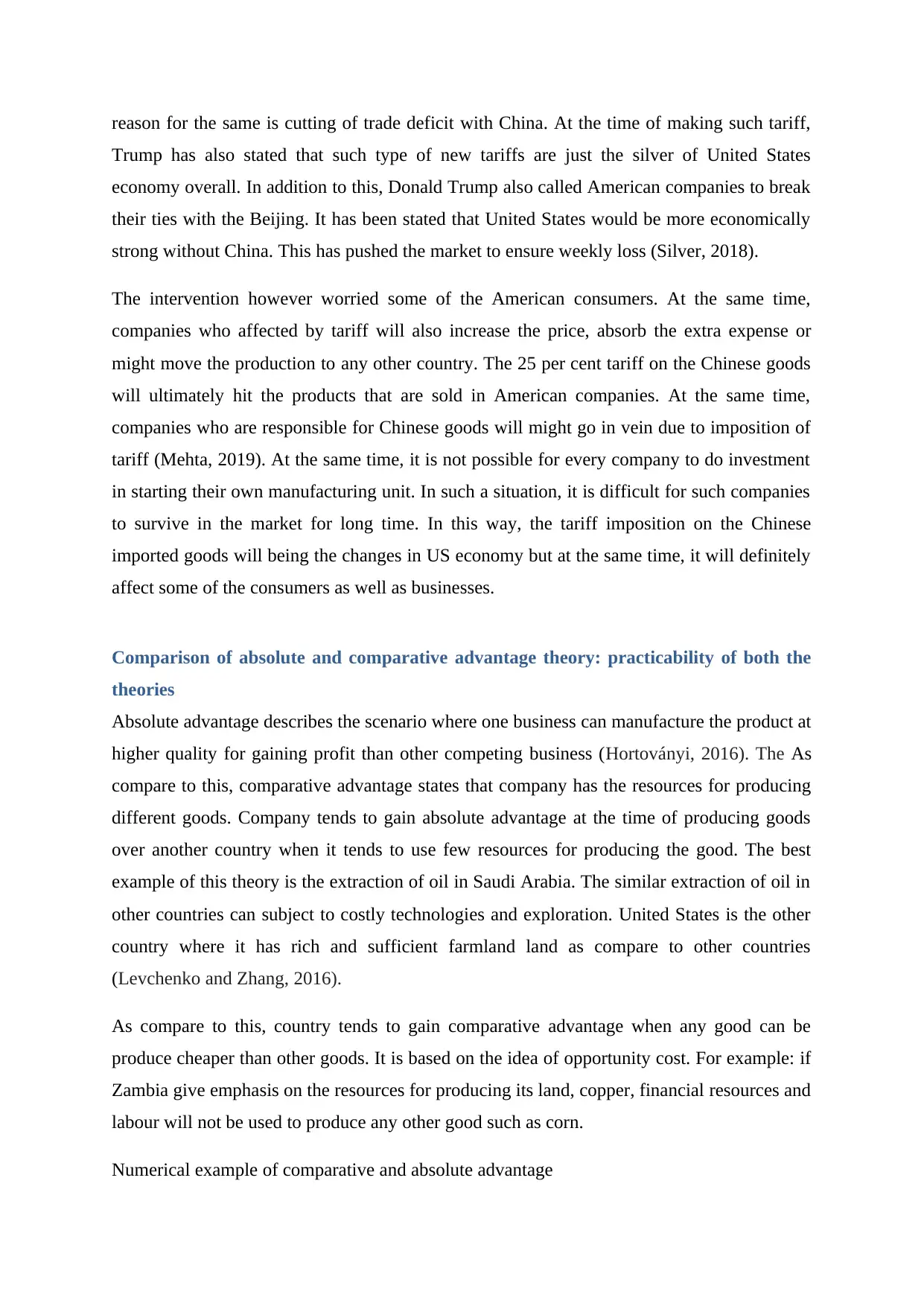
reason for the same is cutting of trade deficit with China. At the time of making such tariff,
Trump has also stated that such type of new tariffs are just the silver of United States
economy overall. In addition to this, Donald Trump also called American companies to break
their ties with the Beijing. It has been stated that United States would be more economically
strong without China. This has pushed the market to ensure weekly loss (Silver, 2018).
The intervention however worried some of the American consumers. At the same time,
companies who affected by tariff will also increase the price, absorb the extra expense or
might move the production to any other country. The 25 per cent tariff on the Chinese goods
will ultimately hit the products that are sold in American companies. At the same time,
companies who are responsible for Chinese goods will might go in vein due to imposition of
tariff (Mehta, 2019). At the same time, it is not possible for every company to do investment
in starting their own manufacturing unit. In such a situation, it is difficult for such companies
to survive in the market for long time. In this way, the tariff imposition on the Chinese
imported goods will being the changes in US economy but at the same time, it will definitely
affect some of the consumers as well as businesses.
Comparison of absolute and comparative advantage theory: practicability of both the
theories
Absolute advantage describes the scenario where one business can manufacture the product at
higher quality for gaining profit than other competing business (Hortoványi, 2016). The As
compare to this, comparative advantage states that company has the resources for producing
different goods. Company tends to gain absolute advantage at the time of producing goods
over another country when it tends to use few resources for producing the good. The best
example of this theory is the extraction of oil in Saudi Arabia. The similar extraction of oil in
other countries can subject to costly technologies and exploration. United States is the other
country where it has rich and sufficient farmland land as compare to other countries
(Levchenko and Zhang, 2016).
As compare to this, country tends to gain comparative advantage when any good can be
produce cheaper than other goods. It is based on the idea of opportunity cost. For example: if
Zambia give emphasis on the resources for producing its land, copper, financial resources and
labour will not be used to produce any other good such as corn.
Numerical example of comparative and absolute advantage
Trump has also stated that such type of new tariffs are just the silver of United States
economy overall. In addition to this, Donald Trump also called American companies to break
their ties with the Beijing. It has been stated that United States would be more economically
strong without China. This has pushed the market to ensure weekly loss (Silver, 2018).
The intervention however worried some of the American consumers. At the same time,
companies who affected by tariff will also increase the price, absorb the extra expense or
might move the production to any other country. The 25 per cent tariff on the Chinese goods
will ultimately hit the products that are sold in American companies. At the same time,
companies who are responsible for Chinese goods will might go in vein due to imposition of
tariff (Mehta, 2019). At the same time, it is not possible for every company to do investment
in starting their own manufacturing unit. In such a situation, it is difficult for such companies
to survive in the market for long time. In this way, the tariff imposition on the Chinese
imported goods will being the changes in US economy but at the same time, it will definitely
affect some of the consumers as well as businesses.
Comparison of absolute and comparative advantage theory: practicability of both the
theories
Absolute advantage describes the scenario where one business can manufacture the product at
higher quality for gaining profit than other competing business (Hortoványi, 2016). The As
compare to this, comparative advantage states that company has the resources for producing
different goods. Company tends to gain absolute advantage at the time of producing goods
over another country when it tends to use few resources for producing the good. The best
example of this theory is the extraction of oil in Saudi Arabia. The similar extraction of oil in
other countries can subject to costly technologies and exploration. United States is the other
country where it has rich and sufficient farmland land as compare to other countries
(Levchenko and Zhang, 2016).
As compare to this, country tends to gain comparative advantage when any good can be
produce cheaper than other goods. It is based on the idea of opportunity cost. For example: if
Zambia give emphasis on the resources for producing its land, copper, financial resources and
labour will not be used to produce any other good such as corn.
Numerical example of comparative and absolute advantage
Paraphrase This Document
Need a fresh take? Get an instant paraphrase of this document with our AI Paraphraser
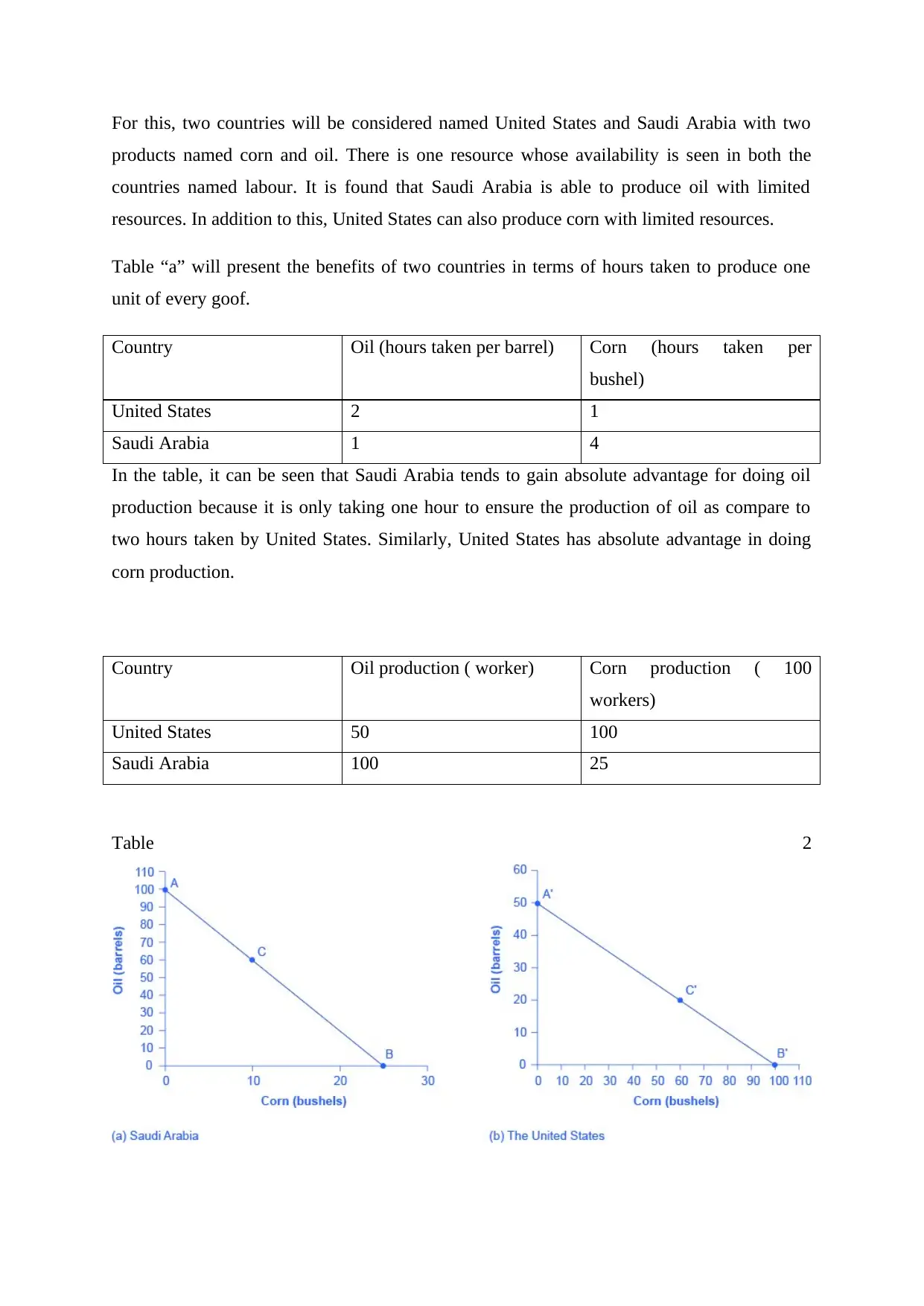
For this, two countries will be considered named United States and Saudi Arabia with two
products named corn and oil. There is one resource whose availability is seen in both the
countries named labour. It is found that Saudi Arabia is able to produce oil with limited
resources. In addition to this, United States can also produce corn with limited resources.
Table “a” will present the benefits of two countries in terms of hours taken to produce one
unit of every goof.
Country Oil (hours taken per barrel) Corn (hours taken per
bushel)
United States 2 1
Saudi Arabia 1 4
In the table, it can be seen that Saudi Arabia tends to gain absolute advantage for doing oil
production because it is only taking one hour to ensure the production of oil as compare to
two hours taken by United States. Similarly, United States has absolute advantage in doing
corn production.
Country Oil production ( worker) Corn production ( 100
workers)
United States 50 100
Saudi Arabia 100 25
Table 2
products named corn and oil. There is one resource whose availability is seen in both the
countries named labour. It is found that Saudi Arabia is able to produce oil with limited
resources. In addition to this, United States can also produce corn with limited resources.
Table “a” will present the benefits of two countries in terms of hours taken to produce one
unit of every goof.
Country Oil (hours taken per barrel) Corn (hours taken per
bushel)
United States 2 1
Saudi Arabia 1 4
In the table, it can be seen that Saudi Arabia tends to gain absolute advantage for doing oil
production because it is only taking one hour to ensure the production of oil as compare to
two hours taken by United States. Similarly, United States has absolute advantage in doing
corn production.
Country Oil production ( worker) Corn production ( 100
workers)
United States 50 100
Saudi Arabia 100 25
Table 2
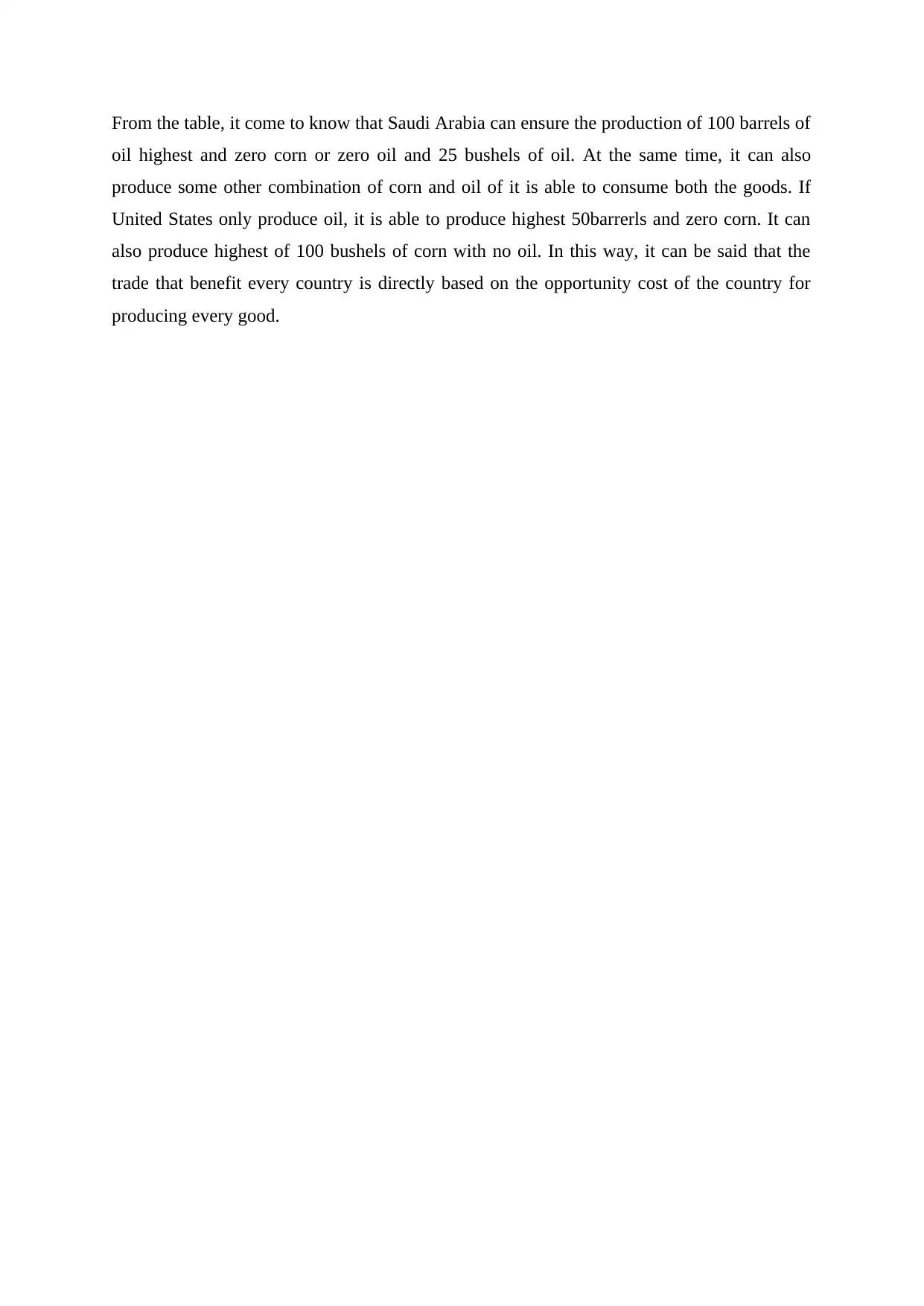
From the table, it come to know that Saudi Arabia can ensure the production of 100 barrels of
oil highest and zero corn or zero oil and 25 bushels of oil. At the same time, it can also
produce some other combination of corn and oil of it is able to consume both the goods. If
United States only produce oil, it is able to produce highest 50barrerls and zero corn. It can
also produce highest of 100 bushels of corn with no oil. In this way, it can be said that the
trade that benefit every country is directly based on the opportunity cost of the country for
producing every good.
oil highest and zero corn or zero oil and 25 bushels of oil. At the same time, it can also
produce some other combination of corn and oil of it is able to consume both the goods. If
United States only produce oil, it is able to produce highest 50barrerls and zero corn. It can
also produce highest of 100 bushels of corn with no oil. In this way, it can be said that the
trade that benefit every country is directly based on the opportunity cost of the country for
producing every good.
⊘ This is a preview!⊘
Do you want full access?
Subscribe today to unlock all pages.

Trusted by 1+ million students worldwide
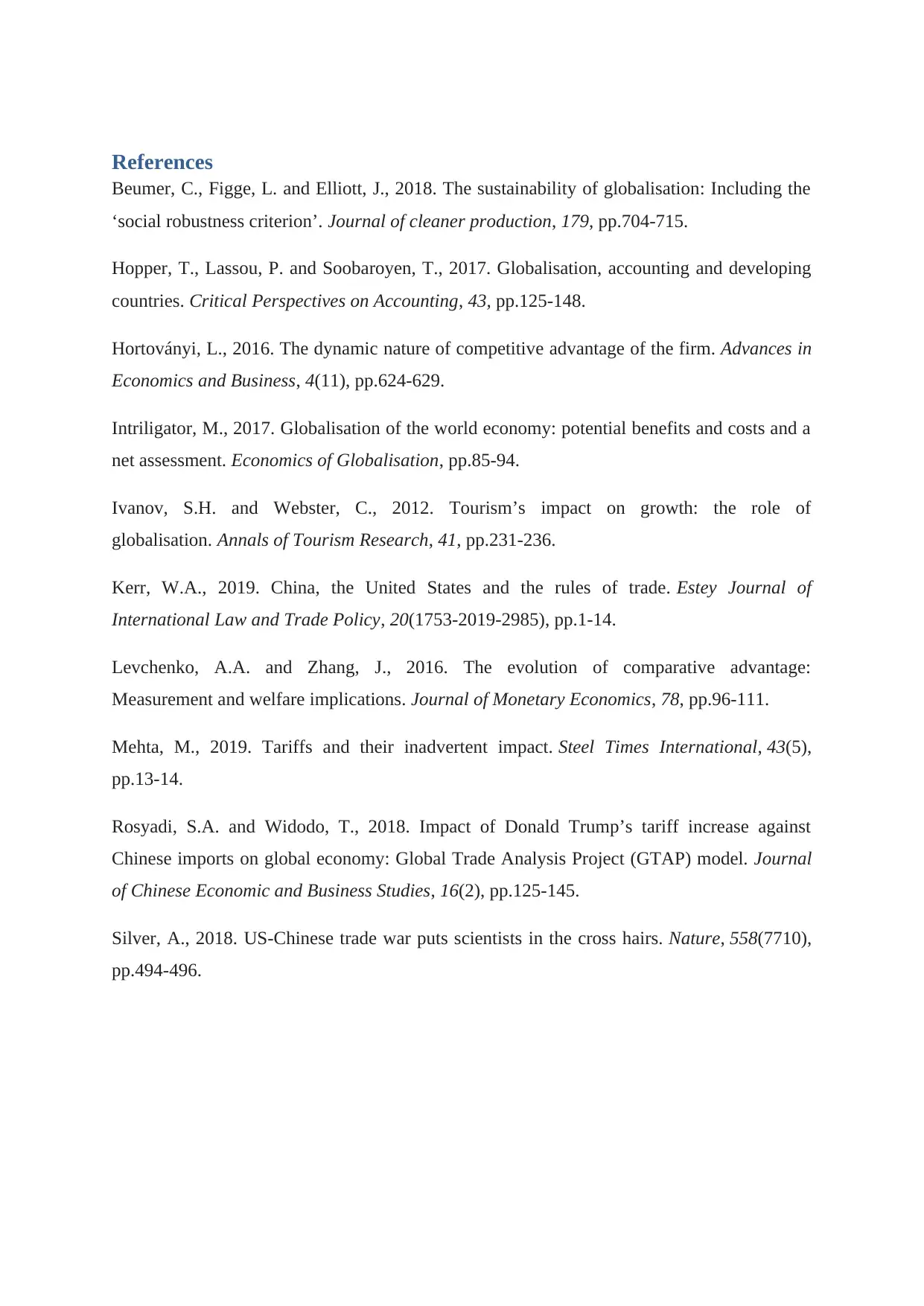
References
Beumer, C., Figge, L. and Elliott, J., 2018. The sustainability of globalisation: Including the
‘social robustness criterion’. Journal of cleaner production, 179, pp.704-715.
Hopper, T., Lassou, P. and Soobaroyen, T., 2017. Globalisation, accounting and developing
countries. Critical Perspectives on Accounting, 43, pp.125-148.
Hortoványi, L., 2016. The dynamic nature of competitive advantage of the firm. Advances in
Economics and Business, 4(11), pp.624-629.
Intriligator, M., 2017. Globalisation of the world economy: potential benefits and costs and a
net assessment. Economics of Globalisation, pp.85-94.
Ivanov, S.H. and Webster, C., 2012. Tourism’s impact on growth: the role of
globalisation. Annals of Tourism Research, 41, pp.231-236.
Kerr, W.A., 2019. China, the United States and the rules of trade. Estey Journal of
International Law and Trade Policy, 20(1753-2019-2985), pp.1-14.
Levchenko, A.A. and Zhang, J., 2016. The evolution of comparative advantage:
Measurement and welfare implications. Journal of Monetary Economics, 78, pp.96-111.
Mehta, M., 2019. Tariffs and their inadvertent impact. Steel Times International, 43(5),
pp.13-14.
Rosyadi, S.A. and Widodo, T., 2018. Impact of Donald Trump’s tariff increase against
Chinese imports on global economy: Global Trade Analysis Project (GTAP) model. Journal
of Chinese Economic and Business Studies, 16(2), pp.125-145.
Silver, A., 2018. US-Chinese trade war puts scientists in the cross hairs. Nature, 558(7710),
pp.494-496.
Beumer, C., Figge, L. and Elliott, J., 2018. The sustainability of globalisation: Including the
‘social robustness criterion’. Journal of cleaner production, 179, pp.704-715.
Hopper, T., Lassou, P. and Soobaroyen, T., 2017. Globalisation, accounting and developing
countries. Critical Perspectives on Accounting, 43, pp.125-148.
Hortoványi, L., 2016. The dynamic nature of competitive advantage of the firm. Advances in
Economics and Business, 4(11), pp.624-629.
Intriligator, M., 2017. Globalisation of the world economy: potential benefits and costs and a
net assessment. Economics of Globalisation, pp.85-94.
Ivanov, S.H. and Webster, C., 2012. Tourism’s impact on growth: the role of
globalisation. Annals of Tourism Research, 41, pp.231-236.
Kerr, W.A., 2019. China, the United States and the rules of trade. Estey Journal of
International Law and Trade Policy, 20(1753-2019-2985), pp.1-14.
Levchenko, A.A. and Zhang, J., 2016. The evolution of comparative advantage:
Measurement and welfare implications. Journal of Monetary Economics, 78, pp.96-111.
Mehta, M., 2019. Tariffs and their inadvertent impact. Steel Times International, 43(5),
pp.13-14.
Rosyadi, S.A. and Widodo, T., 2018. Impact of Donald Trump’s tariff increase against
Chinese imports on global economy: Global Trade Analysis Project (GTAP) model. Journal
of Chinese Economic and Business Studies, 16(2), pp.125-145.
Silver, A., 2018. US-Chinese trade war puts scientists in the cross hairs. Nature, 558(7710),
pp.494-496.
1 out of 7
Related Documents
Your All-in-One AI-Powered Toolkit for Academic Success.
+13062052269
info@desklib.com
Available 24*7 on WhatsApp / Email
![[object Object]](/_next/static/media/star-bottom.7253800d.svg)
Unlock your academic potential
Copyright © 2020–2025 A2Z Services. All Rights Reserved. Developed and managed by ZUCOL.





